Avocado preparation
Hass avocados are ready to eat when their skin is a purple brown colour (no need to squeeze).
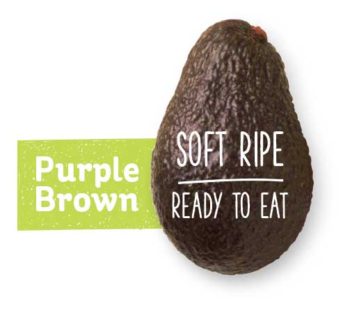
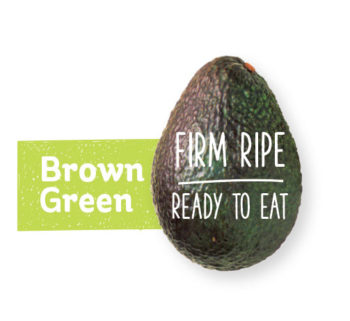
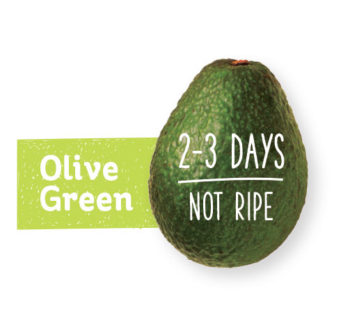
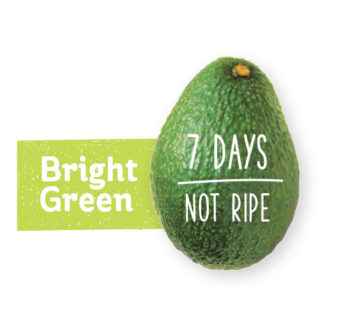
How to select your avocado
Hass Hass avocados change colour as they ripen so choose an avocado based on its colour rather than squeezing as this causes bruising.
Avoid extremely soft avocados with very dark skin or dented or flattened areas.




Avocados will ripen in your fruit bowl but to accelerate the process, pop in a brown paper bag and include a banana or apple. These other fruits give off ethylene gas, which is a ripening agent.
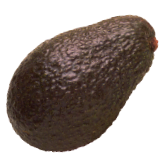
 Purple Brown – soft ripe
Ready to eat. Perfect for any meal. Store in fridge.
Purple Brown – soft ripe
Ready to eat. Perfect for any meal. Store in fridge.

 Brown Green – firm ripe
Ready to eat. Perfect for slicing/dicing or cubes.
Store in fridge to keep firm or continue to ripen in fruit bowl until purple brown.
Brown Green – firm ripe
Ready to eat. Perfect for slicing/dicing or cubes.
Store in fridge to keep firm or continue to ripen in fruit bowl until purple brown.
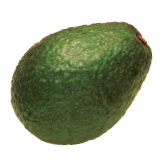
 Olive Green – not ripe
Store in fruit bowl until skin turns brown green.
Olive Green – not ripe
Store in fruit bowl until skin turns brown green.
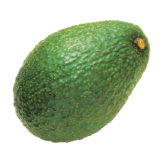
 Bright Green – not ripe
Store in fruit bowl until skin turns brown green.
Bright Green – not ripe
Store in fruit bowl until skin turns brown green.
How to ripen your avocado
Avocados will ripen in your fruit bowl but to accelerate the process, pop in a brown paper bag and include a banana or apple. These other fruits give off ethylene gas, which is a ripening agent. For pre-ripened avocados (those which have been treated with ethylene or other ripening agent to speed the ripening process), simply place in your fruit bowl to finish off the ripening process which should occur in 2 – 3 days.Avocado storage
Ripe fruit can be refrigerated uncut until eaten, but limit this to two or three days.







Uncut ripe avocados can be refrigerated for a few days. Once cut, lemon juice and vinegar can be used to stop from browning or puree with lemon juice and freeze.
How to store your avocado
- Uncut ripe fruit can be refrigerated until eaten, but limit this to two or three days.
- Cut avocado can be sprinkled with lemon juice, lime juice or white vinegar and placed in an air-tight container in the refrigerator. They should be eaten within a day or two. If the top layer goes brown, you can simply scrape this off and you’ll find the flesh underneath is perfectly fine.
- Avocado can be pureed with lemon juice and frozen for up to four months.
There are a number of ways to combat oxidisation on the freshly cut flesh of avocados: store in an air tight container or cover the flesh in lemon juices or wrap in glad wrap.
Eating avocados
Avocado is the perfect baby first food. They are the ideal flavour, consistency and nutritional content. Avocado's smooth, creamy consistency, neutral flavour and excellent nutritional content makes it one of the first fresh fruits your wee one can enjoy. They are a great source of calories, high in healthy fat and help the absorption of fat-soluble vitamins (A, D, E and K) from foods eaten with them. Additionally, avocados are very low in sugar and sodium and contain good amounts of developmental nutrients, such as folate and vitamin E, and are gluten-free. A ¼ avocado serving has 4 grams of unsaturated fats, which are known to be important for normal growth and development of the central nervous system and brain.
Find out more about the nutrition of avocados here
Absolutely, we love to see new avocado recipes. Please send it to communications@nzavocado.co.nz
Avocados should be eaten when the skin is brown and the flesh is a green – yellow colour. Once the flesh starts going brown the avocado is starting to rot. If there is a small amount of brown flesh the green part can still be eaten but it’s best to avoid eating brown flesh.
Yes, avocado oil is very healthy and great for the eyes, skin and heart. It’s great as a 1 to 1 substitute for savoury recipes, sauces and dressings. For baking we would recommend using fresh avocado as a substitute for oil or butter. Due to their mono and polyunsaturated fat content, avocados are a great substitution for foods rich in saturated fat.
Yes, avocados are a great substitute for butter on toast, sandwiches and in baking. Using avocados instead of butter helps to lower the calorie count and add nutrients into your baking. Use ½ the amount of mashed avocado for the substitute.
Check out our baking recipes here
Yes, definitely. Avocados are full of folate which is essential during pregnancy and vital for healthy growth and development for all ages.
Find out more here
Health and Nutrition
Avocados are packed with almost 20 nutrients. They are a nutrient-dense fruit that plays a major role in healthy diets, contributing almost 20 vitamins, nutrients and phytonutrients. Also, avocados are an excellent source of healthy monounsaturated fats, are cholesterol-free and have naturally low levels of sugar and sodium.
The body needs fats as they are vital for good health and avocados are an excellent source of healthy monounsaturated fats. There has been a steady rise in the popularity of adding healthy plant sources of fats such as avocado to well-balanced diets. Wherever you find fat, all three types of fat will be present: monounsaturated, polyunsaturated and saturated but just in different amounts. In plant foods such as avocado, the majority of the fat is the healthy kind: 60% monounsaturated fat and 12% polyunsaturated fat. Half an avocado contains 15g of monounsaturated fat and 3 g of polyunsaturated fat.
One-half of a medium avocado (83.5g) has 893 Kilojoules or 213 calories and contributes nearly 20 vitamins and minerals making it a good nutrient choice.
* Recommended Daily Intake (Average Adult). RDI is based on an average adult diet of 8700 kJ. Your daily intakes may be higher or lower depending on your energy needs.
** Reference values stated for labelling in the Food Standards Code (Standard 1.2.8 Table to Subclause 7(3))
Source: The Concise New Zealand Food Composition Tables, 10th Edition, Plant &Food Research – 2014.
Understanding nutrition information
It is really important that you understand what is in the food you eat. So check out the avocado nutrition information in the table below to see what healthy goodies are in avocados.How to read the nutrition information
- Start with the serving size and servings per package. A serving of avocado is based on 1/2 of a medium avocado or 83.5 g.; there are two servings in a medium avocado
- Check kilojoules / calories.Kilojoules or Calories provide a measure of how much energy you get from a serving of this food.One-half of a medium avocado (83.5g) has 893 Kilojoules or 213 calories and contributes nearly 20 vitamins and minerals making it a good nutrient choice.
- Look at the nutrients to help limit or increase your nutrient consumption.According to the Ministry of Health (MOH) eating too much fat, saturated fat, cholesterol, or sodium may increase your risk of certain chronic diseases, like heart disease, some cancers, or high blood pressure. It is recommended that you keep your intake of saturated fat as low as possible as part of a nutritionally balanced diet.Avocados, due to their mono and polyunsaturated fat content, are a great substitution for foods rich in saturated fat.
- Check the (Recommended daily intake (%RDI) column to see the MOH recommendation for key nutrients (based on an average adult daily diet of 8,700 kilojoules) the avocado provides.
- Servings per kg: 12
- Serving size: 1/2 avocado – 83.5g
|
AVG QUANTITY
PER SERVING |
% DAILY INTAKE PER SERVE |
AVG QUANTITY
PER 100G |
|
|---|---|---|---|
| Energy (kJ/Cal) | 893/213 | 10%** | 1070/256 |
| Protein (g) | 1.7 | 3%** | 2.0 |
| Fat, total (g) | 22.2 | 32%** | 26.6 |
| – saturated (g) | 3.1 | 13%** | 3.7 |
| – polyunsaturated (g) | 2.3 | 2.8 | |
| – monounsaturated (g) | 15.3 | 18.3 | |
| Carbohydrate (g) | 0.5 | 0.2%** | 0.6 |
| – sugars (g) | 0.4 | 0.5%** | 0.5 |
| Dietary Fibre (g) | 4.0 | 13%** | 4.8 |
| Sodium (mg) | 14 | 0.6%** | 17 |
| Vitamin B6 (mg) | 0.77 | 48% RDI* | 0.92 |
| Folate (µg) | 68 | 34% RDI* | 81 |
| Niacin (mg) | 1.3 | 13% RDI* | 1.6 |
| Vitamin E (mg) | 1.6 | 16% RDI* | 1.9 |
| Vitamin C (mg) | 6.1 | 15% RDI* | 7.3 |
| Potassium (mg) | 468 | 560 |
Growing Avocados
Avocado seeds are relatively easy to sprout and is a great project for kids.
- Remove the seed from the avocado and clean the flesh from it
- Skewer the seed around the centre with four toothpicks ensuring you locate the small bump at the bottom of the seed.
- Place seed on a jar of water with the tooth picks resting on the rim, ensuring the bottom half is submerged.
- Sprouting can take between 2 and 8 weeks. Once the sprout reaches about 20cm pot in soil.
Avocados trees grown from seeds can take up to 12 years to start producing fruit. There are many environmental reasons that trees may stop producing fruit such as dry soil, root rot and pruning faults.
For more information please see our orchard management resources here
Avocados are unusual as they do not ripen on the tree, they only ripen once they picked. If they are picked before they are mature avocados will remain rock hard and never ripen. The best way to find out if your avocados are ready to be picked is to pick one, if it ripens within two weeks then the rest should be ready too. If it doesn’t ripen then keep checking every couple of weeks. The main harvest season for Hass avocados (the main variety) in New Zealand is September to April. Good sized avocados on most trees in New Zealand should be ready to pick during this time.
All avocados sold in New Zealand are grown in New Zealand. The main avocado growing regions are Northland and the Bay of Plenty.
Avocados are biennial in their fruit growth; this means that s they have irregular bearing of fruit with seasonal swings in production. One year there will be a large crop and the next the crop may be much smaller.
Watch this video to find out more
General Avocado Questions
Avocado fruit and oil is very effective as a hair or skin mask, it can help to repair dry hair and moisturise the skin.
Avocado is often confused as a vegetable but it’s actually a fruit, more specifically a berry. It’s one of the healthiest fruits as it contains almost 20 nutrients, is naturally low in sugar and one only a few fruits that contains protein.
All avocados sold in New Zealand are grown in New Zealand the main avocado growing regions are Northland and the Bay of Plenty.
Click here to find out more about our avocado growers
The main export season is between August and February but avocados can be supplied year round in New Zealand.
Demand for avocados in New Zealand has increased as more people discover their amazing health benefits and versatility. Prices for avocados in New Zealand can change as a result of supply and demand. As with all fresh produce, prices fluctuate with the supply throughout the year and avocado volumes vary from season to season.
Avocados need to be handled very carefully – more carefully perhaps than any other fruit in the produce section and as such they do not always get the care they need because they get treated like the other more resilient fruit. If you see poor quality avocados in your local supermarket, we suggest that you speak to the produce staff in the store as they may be unaware of the issue without feedback from shoppers.
